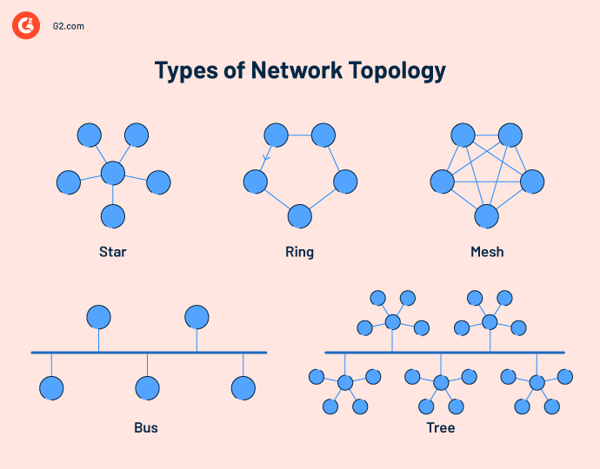What is Network Topology? Types, diagrams and advantages
The structure of any network has a direct impact on how it works. Let's take a metaphor for a transportation network (roads, highways, railways). If any of these links were to drop unexpectedly, the ability to deliver food, clothing, and goods would be severely hampered to its "end users" (its residents).
Similarly, given enterprise networks, it's safe to say that they are extremely crucial.
System administrators need network management tools to keep tabs on a large organization's network devices, and network topology is an invaluable tool for that purpose. But what is it? How does topology work in a network? How can enterprises leverage it for better network management?
Let's find out!
What is Network Topology?Network topology is the physical and analytical arrangement of nodes and links in a network, often represented as a diagram or map.
Network topologies define the layout of networks and the relative placement of traffic flows. Using network topology diagrams, administrators can efficiently place each node for successful data transmission.
Network architecture has a significant impact on its ability to perform intended functions, maintain connectivity, and prevent outages. The question "What is network topology?" can be approached with an understanding of both groups in network topology.
Physical: The physical topology of the network refers to the connections (wires, cables, etc.) of the network construction. The physical network is about configuration, maintenance, and deployment. Logical: Logical network topology is an overall understanding of the network construction, including connected nodes and how data is transmitted over the network. The topology of a logical network includes physical, virtual, and cloud components.Effective network security, monitoring, and management requires a solid understanding of a network's physical and logical topology to ensure that a network is efficient and reliable.
Why is network topology important?The performance of a network is strongly affected by its topology. A well-chosen and regularly maintained network topology improves performance metrics such as power efficiency and data transfer rates.
A network topology diagram is a visual representation and interactive tool for network architecture and design. These illustrations are essential for several reasons, but most importantly for their ability to visualize physical and logical layouts so that administrators can identify connections between devices when troubleshooting.
The type of network topology depends on the construction of the network. Several network configurations are available, each with advantages and disadvantages; some are more optimal than others under certain conditions.
Types of network topologyCreating a local area network (LAN) topology can make or break a business. Regardless of the scope and goals of your network, you can choose from a variety of network topologies, each with advantages and disadvantages.

The most common is the star topology, where each node is directly connected to a single central hub via coaxial, twisted pair or fiber optic cable. This central node is a server. It controls data transmission and functions as a repeater to minimize data loss. Repeaters are computer network components that regenerate...

The structure of any network has a direct impact on how it works. Let's take a metaphor for a transportation network (roads, highways, railways). If any of these links were to drop unexpectedly, the ability to deliver food, clothing, and goods would be severely hampered to its "end users" (its residents).
Similarly, given enterprise networks, it's safe to say that they are extremely crucial.
System administrators need network management tools to keep tabs on a large organization's network devices, and network topology is an invaluable tool for that purpose. But what is it? How does topology work in a network? How can enterprises leverage it for better network management?
Let's find out!
What is Network Topology?Network topology is the physical and analytical arrangement of nodes and links in a network, often represented as a diagram or map.
Network topologies define the layout of networks and the relative placement of traffic flows. Using network topology diagrams, administrators can efficiently place each node for successful data transmission.
Network architecture has a significant impact on its ability to perform intended functions, maintain connectivity, and prevent outages. The question "What is network topology?" can be approached with an understanding of both groups in network topology.
Physical: The physical topology of the network refers to the connections (wires, cables, etc.) of the network construction. The physical network is about configuration, maintenance, and deployment. Logical: Logical network topology is an overall understanding of the network construction, including connected nodes and how data is transmitted over the network. The topology of a logical network includes physical, virtual, and cloud components.Effective network security, monitoring, and management requires a solid understanding of a network's physical and logical topology to ensure that a network is efficient and reliable.
Why is network topology important?The performance of a network is strongly affected by its topology. A well-chosen and regularly maintained network topology improves performance metrics such as power efficiency and data transfer rates.
A network topology diagram is a visual representation and interactive tool for network architecture and design. These illustrations are essential for several reasons, but most importantly for their ability to visualize physical and logical layouts so that administrators can identify connections between devices when troubleshooting.
The type of network topology depends on the construction of the network. Several network configurations are available, each with advantages and disadvantages; some are more optimal than others under certain conditions.
Types of network topologyCreating a local area network (LAN) topology can make or break a business. Regardless of the scope and goals of your network, you can choose from a variety of network topologies, each with advantages and disadvantages.

The most common is the star topology, where each node is directly connected to a single central hub via coaxial, twisted pair or fiber optic cable. This central node is a server. It controls data transmission and functions as a repeater to minimize data loss. Repeaters are computer network components that regenerate...
What's Your Reaction?






















